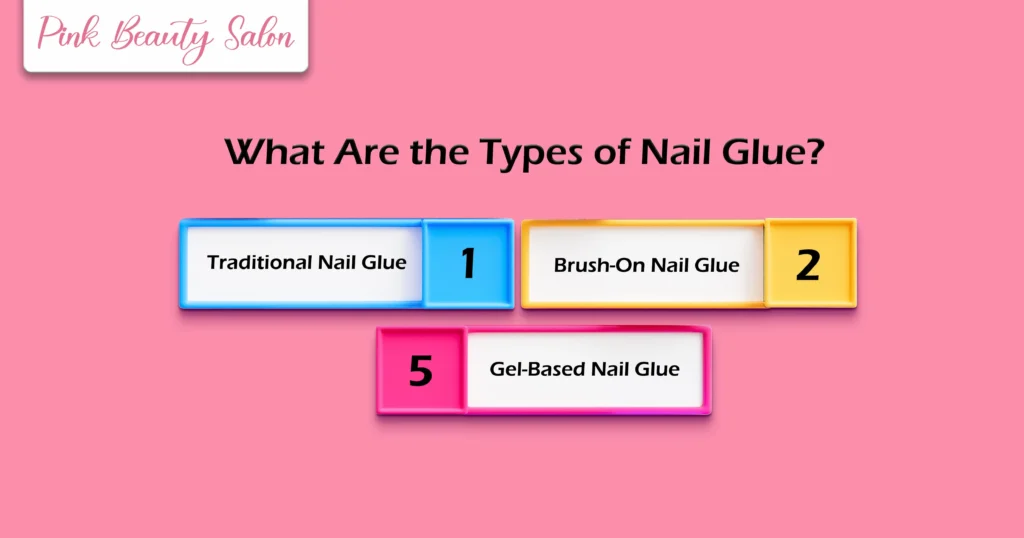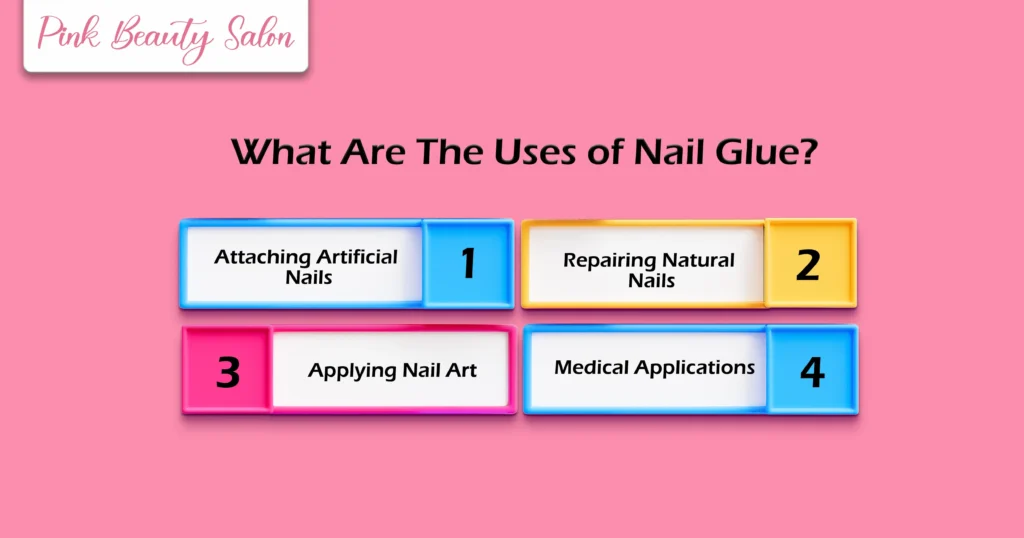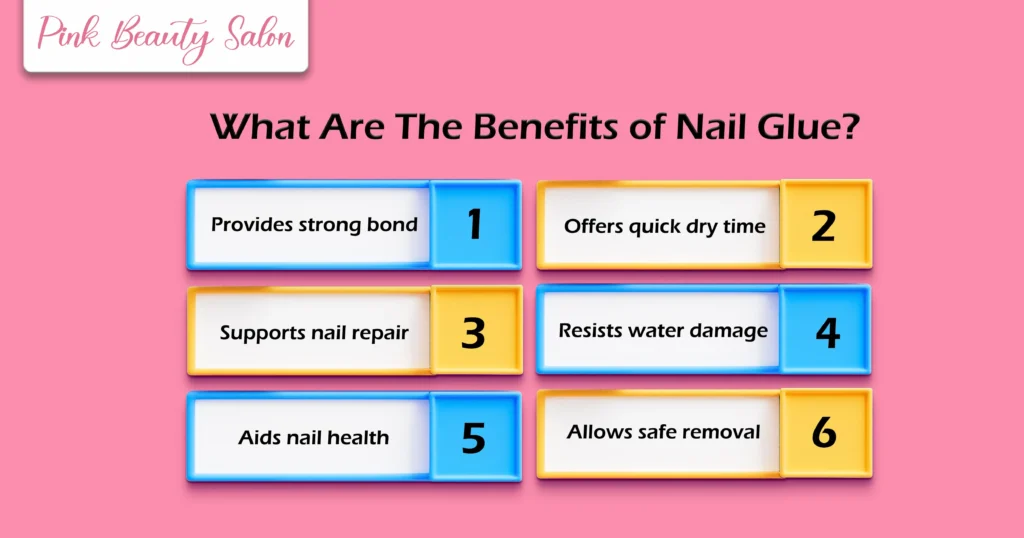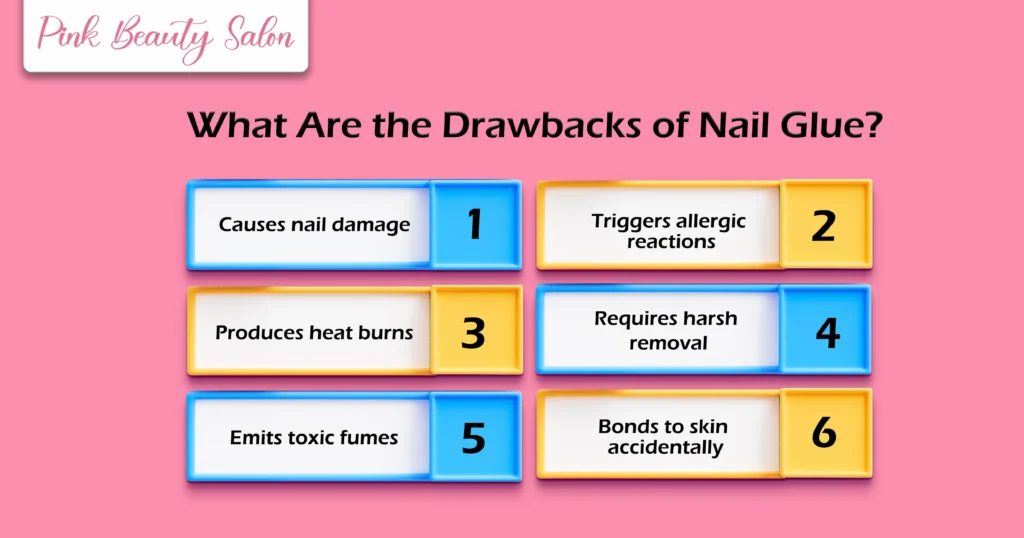Published On: 16 April 2025
In this comprehensive article on nail glue, we explore everything you need to know about this essential nail care product.
We dive into its chemical composition, providing insight into the ingredients that make it effective for bonding artificial nails and repairing damaged nails.
Common questions are answered, such as whether nail glue is the same as super glue, if it is harmful, and if it’s the same as nail polish.
We also discuss important factors like the drying time of nail glue, tips on making it stick longer, and where to apply it for the best results.
The article also covers the various uses, benefits, and potential drawbacks of nail glue, ensuring you’re fully informed before using it.
Whether you’re a professional or a DIY enthusiast, this guide offers everything you need to get the most out of your nail glue.

What is Nail Glue
Nail glue is a fast-drying adhesive designed to bond artificial nails, nail tips, and repairs. It is primarily composed of ethyl cyanoacrylate, a chemical known for its strong adhesion and quick setting time. Upon contact with moisture, it forms a rigid, waterproof bond that secures artificial nails in place.
While commonly used in cosmetic applications, nail glue affects natural nails depending on application and removal methods. Frequent use or improper removal leads to brittleness and thinning of the nail surface.
While cyanoacrylate-based adhesives are known for their strong adhesion, some individuals may experience allergic reactions. Young Hwan Park and team study shows that allergic contact dermatitis occurs in 2.7% of cases with 2-octyl cyanoacrylate and 2.2% with n-butyl cyanoacrylate.
What is The Chemical Composition of Nail Glue?
Nail glue primarily consists of cyanoacrylate monomers, with ethyl cyanoacrylate (ECA) being the most commonly used due to its rapid polymerization and strong adhesion to nails.
Other cyanoacrylate variants, such as butyl and octyl cyanoacrylate, are formulated for medical applications, offering increased flexibility for wound closure.
Beyond cyanoacrylate, polymethyl methacrylate (PMMA) reinforces the adhesive bond, hydroquinone acts as a stabilizer to prevent premature polymerization, and plasticizers like dibutyl phthalate enhance flexibility.
Solvents, including acetone or ethyl acetate, adjust viscosity to ensure a smooth application.
According to a study, nail glue contains ethyl cyanoacrylate, hydroquinone, and organic sulfonic acid, which contribute to its adhesive properties and stability.
These components work together to create a durable, quick-setting adhesive suitable for securing artificial nails.
Is Nail Glue Just Super Glue?
No, nail glue is not just super glue. Nail glue and super glue both utilize cyanoacrylate as their primary adhesive component, but their formulations differ significantly in terms of flexibility, safety, and intended use.
Nail glue is specifically designed for cosmetic use, while super glue is formulated for industrial applications. Nail glue often contains methacrylate or ethyl cyanoacrylate, while super glue typically contains methyl or ethyl 2-cyanoacrylate.
Nail glue maintains flexibility to move with the natural nail, while super glue forms rigid, brittle bonds that can damage nails. Nail glue includes plasticizers and stabilizers to protect the nail surface, while super glue lacks these ingredients, making it harsher and more dehydrating.
Nail glue may still cause allergic contact dermatitis due to common allergens, while super glue has also been linked to allergic and respiratory reactions because of its volatile compounds.
For safe and effective nail applications, nail glue remains the recommended choice over super glue, as it is specifically formulated to provide durability while minimizing damage to natural nails.
Is Nail Glue Harmful to Nails?
Frequent use of nail glue negatively affects natural nails, particularly with improper application or removal. Cyanoacrylate-based adhesives, while ensuring strong adhesion, have been linked to allergic contact dermatitis (ACD), with reported cases of irritation.
Ethyl acetate and hydroquinone, commonly found in nail glues, contribute to irritant reactions and potential nail discoloration.
Improper removal, such as peeling off glued nails, damages the keratin layer, leading to fragility and peeling.
A study by J D Guin’s team reports that cyanoacrylate-based nail glue has been associated with onychodystrophy, nail bed hyperkeratosis, fingertip eczema, and onycholysis, reinforcing the impact of these adhesives on nail health
However, careful application, acetone-based removal, and proper hydration help minimize damage.
Is Nail Glue The Same as Nail Polish?
No, nail glue and nail polish are different products. While both products are used in manicures, nail glue functions as an adhesive, whereas nail polish serves an aesthetic purpose.
Nail glue is a cyanoacrylate-based adhesive, while nail polish is a cosmetic lacquer made with nitrocellulose, plasticizers, resins, and pigments.
Nail glue is designed to bond artificial nails, nail tips, or repair damaged natural nails, while nail polish is applied to enhance the appearance of natural nails.
Nail glue forms a rigid, long-lasting bond, while nail polish creates a flexible, decorative layer. Nail glue undergoes rapid polymerization upon exposure to moisture, while nail polish dries through solvent evaporation.
Nail glue ensures strong adhesion but may cause nail dehydration and brittleness with prolonged use, while nail polish provides shine and surface protection without altering the nail’s structure.
Unlike nail glue, which requires acetone-based removers or soaking, nail polish removes easily with standard acetone or non-acetone removers.
How Long Should You Wait for Nail Glue to Dry?
Nail glue, primarily composed of cyanoacrylate, typically dries within 10 to 30 seconds, depending on the specific formulation and environmental factors such as humidity and temperature. This rapid drying occurs due to the adhesive’s nature, which polymerizes quickly upon exposure to moisture.
Additionally, pcbiochemres indicate that while cyanoacrylate adhesives cure quickly, the bond strength may continue to increase over time, depending on temperature and curing period.
To ensure optimal adhesion, it’s advisable to press and hold the nail in place for at least 10 to 15 seconds after applying the glue. Avoiding contact with water or excessive movement for the first 5 to 10 minutes post-application allows for full curing and enhances bond strength.
While using a nail dryer or fan may expedite the drying process, excessive heat exposure should be avoided to prevent potential weakening of the adhesive bond.
How Do You Make Nail Glue Stick Stronger?
To make nail glue stick stronger, proper nail preparation and application techniques are crucial. Start by cleaning the nails to remove oils, moisture, and residue that can weaken the glue’s bond. Make sure the nails are completely dry before proceeding.
Gently buffing the nail surface with a fine-grit file creates a slightly rough texture, which improves mechanical adhesion.
Choosing a glue that contains ethyl cyanoacrylate and polymethyl methacrylate (PMMA) can significantly enhance strength and durability. PMMA acts as a thickener, helping improve tensile strength and the overall bond of the glue.
When applying the glue, use a thin, even layer to avoid air bubbles, as excess glue can lead to lifting. Press the nail firmly in place for 15 to 30 seconds to ensure a secure bond.
After application, avoid water exposure for at least an hour to allow the glue to cure fully. Sealing the edges with a small amount of glue can also help prevent lifting and extend the wear time.
Where Should You Apply Nail Glue?
For the strongest and safest bond, nail glue should be applied carefully to both the natural nail and the artificial nail. Begin by applying a thin, even layer of glue to the center of the natural nail, avoiding the cuticles and surrounding skin to prevent irritation and lifting.
Then, place a small dot of glue at the center of the underside of the artificial nail.
This dual application helps create strong adhesion while minimizing air pockets. Be sure to position the glue slightly away from the cuticle area to achieve a natural look without any overflow.
For added hold, you can apply a tiny amount of glue along the edges of the artificial nail to reinforce the bond and reduce the risk of premature lifting.
Avoid using too much glue, as excess can interfere with proper curing and increase the chance of skin irritation.
Finally, press and hold the artificial nail in place for 15 to 30 seconds to secure a strong, lasting attachment.
Is it Okay to Use Nail Glue on Skin?
Applying nail glue directly to the skin is not recommended due to potential adverse reactions.
Nail glues typically contain cyanoacrylate, a fast-acting adhesive that bonds upon contact with moisture. When applied to the skin, it can cause irritation, chemical burns, and allergic reactions.
Notably, contact with fabrics like cotton or wool can trigger an exothermic reaction, leading to severe burns.
An article highlights that, an 11-year-old girl suffered second-degree burns when nail glue spilled onto her cotton sock, causing an exothermic reaction that led to severe burns on her foot.
If nail glue accidentally contacts the skin:
- Avoid pulling or peeling: This can tear the skin.
- Soak the area: Use warm, soapy water or an acetone-based remover to dissolve the glue.
- Moisturize: After removal, apply a moisturizer to prevent dryness or irritation.
For safe application, ensure the glue is applied solely to the nail surface, and promptly remove any excess to minimize skin exposure.
What Are the Types of Nail Glue?

Nail glues come in different formulations to suit various application needs and preferences. Here are the most common types used in nail care:
- Traditional Nail Glue
- Brush-On Nail Glue
- Gel-Based Nail Glue
Traditional Nail Glue
Traditional nail glue is a widely used adhesive for attaching artificial nails, known for its quick-drying and strong bonding properties. It is primarily composed of cyanoacrylate compounds, which rapidly polymerize upon contact with moisture.
This glue is commonly used in salons and at home for applying press-on nails, repairing breaks, and securing nail art. Application involves cleaning the natural nail, applying a small drop of glue to either the nail or tip, pressing firmly, and allowing a few seconds for the adhesive to set.
Its main features include ease of use, strong initial bond, and accessibility, though safe use requires adequate ventilation and care to avoid skin contact or exposure to fumes.
Traditional nail glue is known for its ease of use, strong initial bond, and accessibility. However, to ensure safe use, it’s important to provide adequate ventilation and avoid direct skin contact or inhaling fumes.
Brush-On Nail Glue
Brush-on nail glue is a user-friendly adhesive packaged with a built-in brush, allowing for controlled and mess-free application.
Its main chemical component is ethyl cyanoacrylate, a fast-acting compound that polymerizes in the presence of moisture to create a durable bond.
This type of glue is widely used in salons and home settings for press-on nails, quick fixes, and tip applications.
To apply, users prep the nail surface, brush on a thin layer of glue, place the artificial nail or align the repair area, and hold briefly to secure.
This type of glue offers quick drying, controlled application, and strong adhesion, but it should be used with care. Contact with fabrics like cotton or wool can trigger an exothermic reaction, potentially causing burns, as documented in safety case reports.
Gel-Based Nail Glue
Gel-based nail glue is a light-cured adhesive used for attaching artificial nail tips and creating long-lasting nail enhancements.
It contains methacrylate compounds like ethyl methacrylate (EMA) and 2-hydroxyethyl methacrylate (HEMA), which undergo polymerization when exposed to UV or LED light, forming a durable and flexible bond.
This glue is commonly used in both professional salons and home nail applications for its strong hold and clean finish. To apply, users prep the natural nail, apply a small amount of the gel glue, position the artificial nail, and then cure it under a UV or LED lamp for the specified time.
Gel-based nail glue offers a high-strength bond, flexibility, and longer wear, though users must follow safety precautions carefully, as improper use or incomplete curing can lead to allergic skin reactions.
What Are The Uses of Nail Glue?

Nail glue is a versatile product used in both cosmetic and practical applications. From enhancing nail aesthetics to repairing damage, its uses go beyond just beauty routines.
- Attaching Artificial Nails
- Repairing Natural Nails
- Applying Nail Art
- Medical Applications
Attaching Artificial Nails:
Nail glue is primarily used for attaching artificial nails, such as acrylic nails or UV gel nails, to natural nails. It creates a strong, lasting bond that holds the enhancements securely in place.
Nail glue is also used to apply nail wraps or decorative stickers for added design and style. This helps achieve a polished, salon-quality look that lasts.
Repairing Natural Nails:
Nail glue is often used to repair cracked or split natural nails by sealing the damaged area. It provides a quick, temporary fix that helps prevent further breakage. This allows the nail to grow out safely while maintaining its appearance. The glue forms a protective layer, reinforcing the nail until it heals naturally.
Applying Nail Art:
Nail glue is used to apply nail art decorations such as rhinestones, decals, and small embellishments. It ensures that these accessories stay securely in place during daily activities.
The strong adhesive helps maintain the design’s integrity and prevents pieces from falling off. This adds a long-lasting, decorative touch to manicures.
Medical Applications:
Medical-grade cyanoacrylate adhesives, such as 2-octyl cyanoacrylate, are used in wound closure and surgical procedures, offering a safe and effective alternative to traditional suturing.
According to Chul Seung Lee and team, these adhesives reduce the rate of superficial surgical site infections and lower overall wound care costs compared to skin staplers.
How to Use Nail Glue?
Using nail glue properly ensures a strong, lasting bond and reduces the risk of damage. Follow these simple steps:
- Prep Your Nails
- Apply the Nail Glue
- Press and Hold
- Clean Excess Glue
- Let It Set
Prep Your Nails
To use nail glue effectively, proper nail preparation is essential for achieving a strong, long-lasting bond. Begin by cleaning your nails with 70% isopropyl alcohol to remove any natural oils, dirt, or residue that could interfere with adhesion.
Once the nails are clean and dry, gently buff the surface with a 180-grit buffer to create a slightly rough texture—this helps the glue grip better by increasing surface contact.
Next, carefully push back your cuticles to prevent the glue from touching the skin, which not only creates a cleaner application but also reduces the risk of allergic reactions to (meth)acrylate compounds often found in nail glues.
Apply the Nail Glue
When applying nail glue, it’s important to use the right amount and technique to ensure a strong, safe bond. Start by applying a thin, even layer of cyanoacrylate-based glue to both the natural nail and the underside of the artificial nail.
Using a minimal amount is crucial, as thicker layers can actually weaken the adhesive’s cohesion and lead to lifting or poor hold. Be careful to avoid contact with the surrounding skin, since nail glue can cause chemical burns or trigger allergic contact dermatitis.
By applying the glue precisely and evenly, you create a secure and lasting attachment without compromising nail or skin health.
Press and Hold
After applying the glue, firmly press the artificial nail onto the natural nail and hold it in place for 10 to 15 seconds to allow proper polymerization. This step is essential for forming a strong initial bond.
During this time, avoid contact with materials like cotton or wool, as cyanoacrylate glue can react with these fibers and cause an exothermic reaction, potentially resulting in burns.
Once the nail is secured, allow at least five minutes for the glue to fully cure before exposing your hands to water or lotions.
Research indicates that both humidity levels and curing time play a crucial role in achieving maximum adhesion strength and durability.
Clean Excess Glue
If any excess glue seeps out during application, carefully wipe it away using a lint-free cloth soaked in acetone to maintain a smooth and even finish. This helps prevent buildup that can lead to lumps or an uneven appearance.
Avoid using tissues or cotton swabs, as cyanoacrylate glue reacts with natural fibers, potentially causing a heat-producing chemical reaction that can result in burns. Handling excess glue promptly and safely ensures a cleaner, more professional-looking result.
Let It Set
Allow the glue to fully cure for at least 5 minutes before exposing nails to water, lotions, or pressure.
What Are The Benefits of Nail Glue?

Nail glue offers several advantages that make it a go-to product for both everyday users and professionals. Nail glue is important because nail glue:
- Provides strong bond
- Offers quick dry time
- Supports nail repair
- Resists water damage
- Aids nail health
- Allows safe removal
1. Provides Strong Bond
One of the key benefits of nail glue is its ability to create a strong and long-lasting bond. Upon curing, nail glue forms a durable polymer network that securely attaches artificial nails, tips, and decorative elements for extended wear.
This bond is designed to withstand daily activities without weakening, offering a reliable solution for those seeking lasting results.
2. Offers Quick Dry Time
Nail glue offers a strong and long-lasting hold, keeping artificial nails secure for extended periods. Its quick-drying formula sets within seconds, allowing for fast and efficient application without long wait times.
With precise applicators, it provides excellent control for clean, mess-free results. Additionally, it’s versatile—perfect for fixing broken nails, attaching nail tips, or applying nail art accessories with ease.
3. Supports Nail Repair
Nail glue isn’t just for attaching press-on nails—it’s a go-to solution for a variety of nail care needs. It’s commonly used to repair cracked or broken natural nails, helping to prevent further splitting.
Studies show that cyanoacrylate adhesives can bond split nail plates, acting like a protective stent or splint. This highlights its versatility, as it forms a barrier, reduces mechanical stress, and supports the nail’s natural healing process without additional damage.
4. Resists Water Damage
Thanks to the hydrophobic nature of cyanoacrylate polymers, nail glue holds strong even after exposure to water—unlike traditional adhesives that tend to weaken when wet.
This water-resistant quality helps keep the nails securely bonded, reducing the risk of lifting. It also prevents moisture buildup beneath the nail, which helps lower the chances of fungal infections. Overall, it adds an extra layer of protection to maintain nail health.
5. Aids Nail Health
Medical-grade cyanoacrylate adhesives, such as 2-octyl cyanoacrylate, effectively seal minor nail injuries and reinforce fragile nails. Eric J Strauss & team demonstrates that 2-octyl cyanoacrylate (Dermabond) provides strong adhesion and faster repair times compared to traditional sutures, promoting efficient healing and maintaining nail integrity.
Its ability to create a protective barrier supports nail recovery and reduces external damage, making it a valuable option for overall nail health.
6. Allows Safe Removal
When removed correctly using acetone-based solutions, nail glue dissolves without excessive damage to the natural nail plate. Unlike mechanical removal methods, acetone-based removal minimizes keratin degradation, preserving nail integrity.
For those wondering how to remove nail glue at home, using acetone with proper care is the safest and most effective method.
What Are the Drawbacks of Nail Glue?

While nail glue is effective, it does come with some potential risks and limitations to be aware of.
- Causes nail damage
- Triggers allergic reactions
- Produces heat burns
- Requires harsh removal
- Emits toxic fumes
- Bonds to skin accidentally
1. Causes Nail Damage
Nail glue, primarily composed of cyanoacrylate-based adhesives, creates a strong bond but weakens natural nails over time. Frequent application and improper removal may lead to keratin degradation, causing brittleness and peeling.
2. Triggers Allergic Reactions
One drawback of nail glue is the potential risk of allergic reactions and skin irritation, especially with frequent or improper use. Certain nail glue formulations contain (meth)acrylates, which are known allergens identified in dermatological studies.
For individuals sensitive to these compounds, exposure can lead to allergic contact dermatitis—often presenting as redness, itching, and swelling around the nail area. To minimize this risk, it’s important to avoid direct skin contact and consider doing a patch test before full application.
3. Produces Heat Burns
Another safety concern with nail glue is its reaction with natural fibers like cotton or wool, which can generate intense heat and lead to burns.
A case report has reported an incident of first- and second-degree burns caused by accidental contact between cyanoacrylate adhesives and fabrics.
This reaction happens quickly and can be harmful if not handled carefully. To avoid such incidents, it’s important to keep the glue away from clothing, tissues, cotton swabs, or any fabric during use.
4. Requires Harsh Removal
Unlike temporary adhesives, nail glue isn’t easily removed and requires acetone-based removers to break down effectively. While acetone gets the job done, it’s a harsh solvent that can cause dryness and thinning of the nails with repeated use.
Over time, prolonged exposure strips away the natural oils from both the nails and surrounding skin, leading to increased fragility, brittleness, and irritation. Proper aftercare is essential to minimize these effects.
5. Emits Toxic Fumes
Nail glues release volatile organic compounds (VOCs), including ethyl cyanoacrylate (ECA), which can cause eye irritation, dizziness, and respiratory discomfort in poorly ventilated areas.
A Study by I Lindström & Team on beauty professionals working with cyanoacrylate-based eyelash extension glue found that prolonged exposure led to occupational asthma (OA) and rhinitis (OR), even when VOC levels were below irritation thresholds.
Since nail glues contain the same cyanoacrylate-based compounds, similar respiratory risks apply to nail technicians, making proper ventilation and protective measures essential to minimize health risks
6. Bonds to Skin Accidentally
According to poison, Cyanoacrylate-based adhesives, commonly found in products like nail glue, rapidly bond to skin upon contact, leading to accidental adhesion. This bonding can cause skin irritation and pain, especially when attempting to separate bonded areas.
Improper removal methods, such as forcibly pulling bonded skin apart, can result in tissue damage or abrasions, potentially necessitating medical intervention.
To safely detach bonded skin, it is recommended to soak the affected area in warm, soapy water, acetone, or isopropyl alcohol, or to lubricate with oil or petroleum jelly to facilitate separation. Avoiding forceful separation is crucial to prevent injury.
Conclusion
Nail glue is a versatile and essential tool in both nail care and beauty routines. From attaching artificial nails to repairing natural ones, its benefits are clear—but it’s just as important to understand the potential drawbacks and use it safely.
By knowing the best nail glue for fake nails, proper use, and how to remove nail glue at home, you can make the most of it while protecting your nail health.
